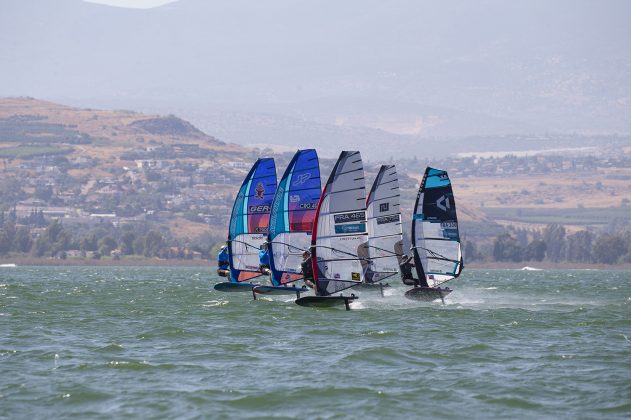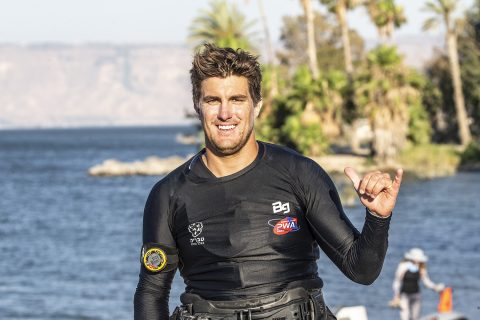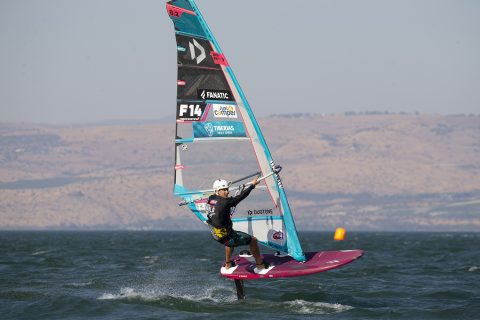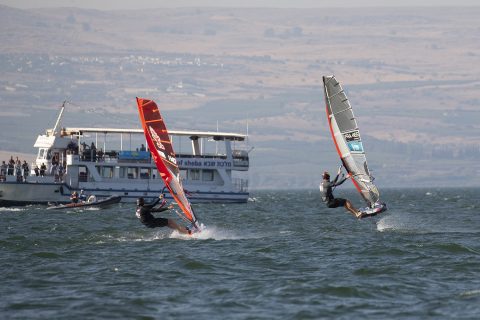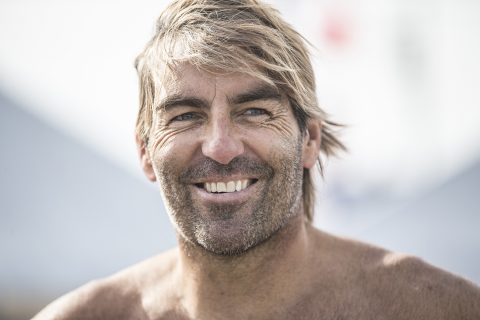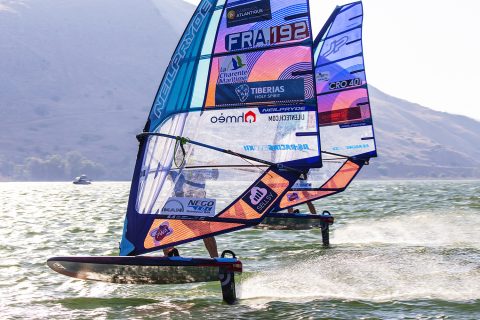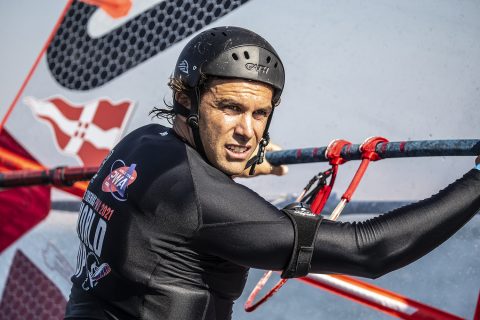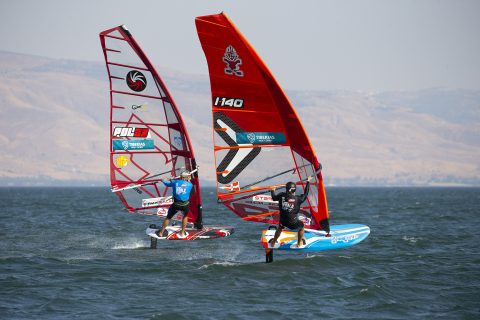The pros make it look easy, but what does it take to go fast on a foil? In these early days of wind foil racing, everyone is trying to figure it out. We asked some PWA top guns for their thoughts?
PHOTOS – John Carter / pwaworldtour.com // WORDS – NICOLAS GOYARD, ANTOINE ALBEAU, MATTEO IACHINO, PIERRE MORTEFON.
PIERRE MORTEFON
- Pierre Mortefon
The most important thing for me is to be stable. If you are not stable and comfortable you can go fast for a few seconds, but then you will crash or have to shut down. For this I think using long harness lines is one of the key things that helps. The equipment has to be stable and the sail is also important. This is why we are using different sails for foiling also. The foil sails are more stable than a regular slalom sail. In the Israel PWA event, when it was windy enough for my 6.2 sail, I just used my normal 6.2 on the foil. I used it with the same settings as in fin windsurfing. But sometimes I use the lower clew, that is the only difference, as well as the long harness lines. When you are unstable you go up and down and it is much harder to sail in the same direction, plus you will not reach your top speed. When you are stable, you accelerate and the acceleration can have almost no limit. The sail needs to stay more upright, but we don’t have the same body position as in fin windsurfing. It is more like sitting without pulling a lot on your arms. You more pull through your backside and the harness. So you are using the lower part of your body’s weight. You really feel it when you switch from foil to fin. In regular windsurfing you are killing your arms. In light winds on the foil, you really have to glide and be smooth on your equipment. In stronger winds you need to let the equipment do the work for you. But not too much, because you have a lot of power there. In light winds you almost sail with your fingertips on the boom. In high winds you need to hold it. If you feel like you are going to crash, you can try to open the sail a little or just come down. When you really go down, it gives you stability and it helps you stay on the equipment.
- Pierre full speed
NICOLAS GOYARD
A great tip is don’t be afraid of crashing! Crashing is the key to improving and to know what your limits are. Then you can try new settings to find what works for you. The only way to learn to crash is by crashing! In fact, if you never crash, you will not learn how to react if it ever happens. It is good for your body to know how to react and what to do if things go wrong. To get used to being on the edge you need to be able to react faster. Once you have been faster, when you slow down a little, then you are more at ease.
Tuning also makes a big difference and is super precise, especially the angle of the stabilizer. People don’t really realize how critical this is. The rake of the foil is also extremely important. The angle of the board over the water is vital too, otherwise you touchdown more often. With a good rake you can touch the water and go straight back up again. The two settings on the rake and the stabilizer angle are the basics you need to adjust.
Also, I would say don’t be afraid of having some front foot power. Front foot power allows you to get back on the foil if you touch the water. Otherwise, if you have a touchdown, and you are pushing on the back foot, the board gets stuck on the water and you can crash. So it is good to have some balance between front foot and back foot pressure. With the front foot pressure you want something you can rely on to push against.
I would say that to be fast on the foil you also need to be comfortable. If you are not comfortable you cannot go fast or you are going to crash. That is the basics! To learn to be fast you have to have some balls! Once you learn how and you are able to be fast and comfortable at a certain speed and it feels ok, then it’s time to go to the next level! And then you need to have some balls again, because you are pushing yourself to the limits and that is always scary. This is the good thing about our sport. And because foiling is new, we have so much to improve!
- Nico taking on the fin with the foil
ANTOINE ALBEAU
- Antoine Albeau
First you need to be stable and comfortable. If you have these things then you are going to go fast. The main problem in foiling is that the foils we have can go faster, but we have problems with stability. That is why you cannot fully sheet in because otherwise you will fly away or dive down in a big gust and glue the board on the water. The difficulty is to keep comfortable on the foil. You can be flying really well and then you enter a gust which can give you too much power. Then you feel the wings are coming closer to the surface and if they go out of the water then you have a tendency to catapult. Some sailors go up and down like a yo-yo on the foil and that is because they are missing stability. You need to have perfect tuning between the front wing and the back wing. The length of the fuselage as well is critical. The sail needs to be stable and not moving around as well. For slalom, the board is touching the water so the sail is moving a lot and needs to be soft. In foil you need to have a stiffer sail. The board is not hitting the water at all, so the sail needs to be more locked in with a shorter boom and bigger foot as well. That is the difference. It really is difficult to go fast. It is super technical. If you are sailing alone, you can use a small sail. Nico Goyard was on 6m and was going way faster than us. He had no problem to arrive in the lead at the first mark. If he was fighting amongst us, he would have needed to be on 7m for sure. On that small sail he had less drag and then normally you naturally go faster. Nico had some extremely fast times on the GPS, so we knew he was fast on the foil. He had made public the speeds he was doing, so we knew he was fast. He was sailing in France before the PWA Israel event and the guys that were with him on slalom gear knew he was incredibly fast on the foil. Goyard is an engineer so he understands what goes on with the wings. We are all engineers now! You need to be an engineer to foil fast!
- Albeau charging
MATTEO IACHINO
- Matteo Iachino
Be comfortable as usual. The more comfortable you are, the more you can focus on being faster. If you are wobbling and stuff, it is going to be a lot harder to go fast. If you feel drag then the slower you will go. In foiling the tuning of your equipment is really key. With fins, the rider can alter things a little by pushing more, but on the foil if your gear does not work then forget it. You really need to tune everything. You need to tune to your own preferences. Some guys like higher flying boards and some like lower boards. Also, some guys like to sail more back footed or front footed. With Starboard we have a guide on how to install the spacers and set up the foil and the wings. Then you must test yourself. If it is flat water, it is one thing, as waves can mean different settings. There are no set rules. It can depend on which sail you put on the board. If a sail is pushing down too much then you want more power, otherwise the board is nose diving all the time and you have to push back to stop it dragging. As I said, there isn’t rules to go fast, rather there are main directions and then you have to adjust your gear. The more neutral you can be on your equipment, the faster you go! You want a comfortable stance, you need to feel like you don’t have to push with either the back foot or the front foot. The sail should be just sitting down and that is it. You should just be gliding. It is not like slalom where you must sit back and push. On the foil you are just sitting and all the gear has to do the work for you. You stay as steady as possible without moving and the gear does the job!
- Matteo flying

